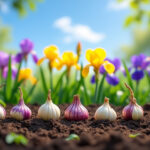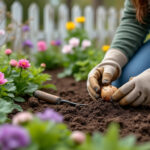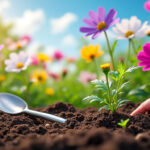Irises, treasured for their striking beauty and versatility, have captured the hearts of gardeners for generations. With such a diverse array of species and colors, selecting the right time to plant iris bulbs is crucial for achieving optimal blooms in a serene landscape. Whether aiming for a full summer garden or a vibrant spring display, understanding the specific needs of various iris types will ensure continued success in the garden.
Timing for Planting Iris Bulbs: A Seasonal Overview
The best time to plant iris bulbs varies based on the species. A significant majority of irises flourish when planted in late summer to early fall, specifically between July and September. This timing allows their roots to establish robustly before winter arrives.Dutch irises, for instance, thrive when planted in the fall, ensuring blooming starts in early spring. Interestingly, areas with warmer climates may extend this window into October.
Spring Planting Considerations
While most gardeners opt for fall plantings, certain varieties, such as Siberian and Japanese irises, may also benefit from being planted in spring. This choice allows them to develop roots comfortably before facing the intense heat of summer. As a result, these species add a spectacular splash of color to the summer garden palette.
Cultivating Bearded Irises: Best Practices
For bearded irises, which are known for their lavish flowering and diversity, the planting window aligns closely with the same late summer to early fall schedule. This ensures that the plants have ample time to establish healthy root systems. If planted too early in the spring, they may bloom prematurely, risking weaker plants in the long run.
| Type of Iris | Planting Time | Blooming Period |
|---|---|---|
| Dutch Iris | August-October | Early Spring |
| Bearded Iris | Mid-summer to Early Fall | Spring to Late Summer |
| Siberian Iris | Late Summer to Spring | Summer |
Dividing Established Irises
After several growing seasons, bearded irises may require division to prevent overcrowding. The best time to undertake this task is after the blooms have faded and the plants have died back naturally. Dividing and replanting during late summer or fall promotes vigor, ensuring healthy and vibrant new growth come spring.
Optimal Planting Conditions for Irises
Regardless of the species, irises thrive in well-draining soil rich in organic matter. It’s advisable to amend the soil with compost and, if necessary, grit to ensure proper drainage. Irises favor full sun and should receive at least six to eight hours of sunlight daily for best results. This not only encourages robust growth but also vibrant, abundant blooms.
| Soil Preparation Tips | Recommended Actions |
|---|---|
| Check Soil Quality | Ensure soil is neutral to slightly acidic. |
| Digging Depth | Hole should be 4 inches deep and 10 inches wide. |
| Irrigation | Water gently after planting to aid establishment. |
Common Misconceptions
During garden planning, an important note for novice gardeners is that spring plantings, though possible, should be approached cautiously. Understanding specific iris species and their preferences minimizes the risk of weakening the plants. Establishing a well-thought-out plan can lead to a thriving display of irises that enhances garden aesthetics year after year.
The ultimate seasonal guide to pruning grape vines for maximum growth
Frequently Asked Questions
Do iris bulbs need to be soaked before planting? No, soaking is not necessary; however, it can help to loosen rhizomes for easier planting.
How much sunlight do irises need? Irises require full sun, ideally 6-8 hours a day for optimal growth.
When is it best to plant irises for summer blooms? The best period for planting is late summer or early fall, ensuring blooms for the following spring or summer.
Can bearded irises be planted in spring? Yes, but fall planting is generally recommended for stronger growth.
What is the best soil for irises? Well-draining soil, rich in organic matter, is essential for healthy iris growth.
















